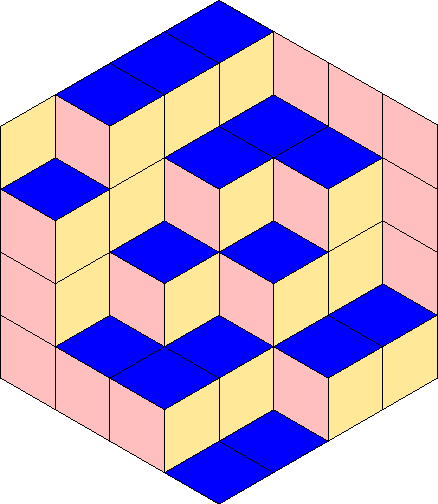Following the methods used by Derksen–Weyman in [] and Chindris in [], we use quiver theory to represent the generalized Littlewood–Richardson coefficients for the branching rule for the diagonal embedding of as the dimension of a weight space of semi-invariants. Using this, we prove their saturation and investigate when they are nonzero. We also show that for certain partitions the associated stretched polynomials satisfy the same conjectures as single Littlewood–Richardson coefficients. We then provide a polytopal description of this multiplicity and show that its positivity may be computed in strongly polynomial time. Finally, we remark that similar results hold for certain other generalized Littlewood–Richardson coefficients.
Revised:
Accepted:
Published online:
Keywords: Quiver representations, semi-invariants, Littlewood–Richardson coefficients, Horn’s Conjecture, branching rule, hive model.
Collins, Brett 1
 CC-BY 4.0
CC-BY 4.0
@article{ALCO_2020__3_6_1365_0,
author = {Collins, Brett},
title = {Generalized {Littlewood{\textendash}Richardson} coefficients for branching rules of {GL}$(n)$ and extremal weight crystals},
journal = {Algebraic Combinatorics},
pages = {1365--1400},
publisher = {MathOA foundation},
volume = {3},
number = {6},
year = {2020},
doi = {10.5802/alco.143},
language = {en},
url = {https://alco.centre-mersenne.org/articles/10.5802/alco.143/}
}
TY - JOUR AU - Collins, Brett TI - Generalized Littlewood–Richardson coefficients for branching rules of GL$(n)$ and extremal weight crystals JO - Algebraic Combinatorics PY - 2020 SP - 1365 EP - 1400 VL - 3 IS - 6 PB - MathOA foundation UR - https://alco.centre-mersenne.org/articles/10.5802/alco.143/ DO - 10.5802/alco.143 LA - en ID - ALCO_2020__3_6_1365_0 ER -
%0 Journal Article %A Collins, Brett %T Generalized Littlewood–Richardson coefficients for branching rules of GL$(n)$ and extremal weight crystals %J Algebraic Combinatorics %D 2020 %P 1365-1400 %V 3 %N 6 %I MathOA foundation %U https://alco.centre-mersenne.org/articles/10.5802/alco.143/ %R 10.5802/alco.143 %G en %F ALCO_2020__3_6_1365_0
Collins, Brett. Generalized Littlewood–Richardson coefficients for branching rules of GL$(n)$ and extremal weight crystals. Algebraic Combinatorics, Volume 3 (2020) no. 6, pp. 1365-1400. doi : 10.5802/alco.143. https://alco.centre-mersenne.org/articles/10.5802/alco.143/
[1] Eigenvalues of products of unitary matrices and quantum Schubert calculus, Math. Res. Lett., Volume 5 (1998) no. 6, pp. 817-836 | DOI | MR | Zbl
[2] Horn inequalities and quivers (2018) (https://arxiv.org/abs/1804.00431)
[3] Local systems on for a finite set, Compositio Math., Volume 129 (2001) no. 1, pp. 67-86 | DOI | MR | Zbl
[4] Geometric proofs of Horn and saturation conjectures, J. Algebraic Geom., Volume 15 (2006) no. 1, pp. 133-173 | DOI | MR | Zbl
[5] Geometric proof of a conjecture of Fulton, Adv. Math., Volume 216 (2007) no. 1, pp. 346-357 | DOI | MR | Zbl
[6] The saturation conjecture (after A. Knutson and T. Tao), Enseign. Math. (2), Volume 46 (2000) no. 1-2, pp. 43-60 (With an appendix by William Fulton) | MR | Zbl
[7] A max-flow algorithm for positivity of Littlewood–Richardson coefficients, 21st International Conference on Formal Power Series and Algebraic Combinatorics (FPSAC 2009) (Discrete Math. Theor. Comput. Sci. Proc., AK), Assoc. Discrete Math. Theor. Comput. Sci., Nancy, 2009, pp. 265-276 | MR | Zbl
[8] Deciding positivity of Littlewood–Richardson coefficients, SIAM J. Discrete Math., Volume 27 (2013) no. 4, pp. 1639-1681 | DOI | MR | Zbl
[9] Quivers, long exact sequences and Horn type inequalities, J. Algebra, Volume 320 (2008) no. 1, pp. 128-157 | DOI | MR | Zbl
[10] Quivers, long exact sequences and Horn type inequalities. II, Glasg. Math. J., Volume 51 (2009) no. 2, pp. 201-217 | DOI | MR | Zbl
[11] Horn’s problem and semi-stability for quiver representations, Representations of algebra. Vol. I, II, Beijing Norm. Univ. Press, Beijing, 2002, pp. 40-48 | MR | Zbl
[12] On the computation of Clebsch–Gordan coefficients and the dilation effect, Experiment. Math., Volume 15 (2006) no. 1, pp. 7-19 | DOI | MR | Zbl
[13] On the number of subrepresentations of a general quiver representation, J. Lond. Math. Soc. (2), Volume 76 (2007) no. 1, pp. 135-147 | DOI | MR | Zbl
[14] Semi-invariants of quivers and saturation for Littlewood–Richardson coefficients, J. Amer. Math. Soc., Volume 13 (2000) no. 3, pp. 467-479 | DOI | MR | Zbl
[15] On the Littlewood–Richardson polynomials, J. Algebra, Volume 255 (2002) no. 2, pp. 247-257 | DOI | MR | Zbl
[16] The combinatorics of quiver representations, Ann. Inst. Fourier (Grenoble), Volume 61 (2011) no. 3, pp. 1061-1131 | DOI | Numdam | MR | Zbl
[17] Cluster algebras and semi-invariant rings I. Triple flags, Proc. Lond. Math. Soc. (3), Volume 115 (2017) no. 1, pp. 1-32 | DOI | MR | Zbl
[18] Young tableaux. With applications to representation theory and geometry, London Mathematical Society Student Texts, 35, Cambridge University Press, Cambridge, 1997, x+260 pages | MR | Zbl
[19] Eigenvalues of sums of Hermitian matrices (after A. Klyachko), Séminaire Bourbaki (Astérisque), Volume 1997/98, Société Mathématique de France, 1998 no. 252, pp. 255-269 (Exp. No. 845) | MR | Zbl
[20] Geometric algorithms and combinatorial optimization, Algorithms and Combinatorics, 2, Springer-Verlag, Berlin, 1993, xii+362 pages | DOI | MR | Zbl
[21] Eigenvalues of sums of Hermitian matrices, Pacific J. Math., Volume 12 (1962), pp. 225-241 | DOI | MR | Zbl
[22] Toric degeneration of branching algebras, Adv. Math., Volume 220 (2009) no. 6, pp. 1809-1841 | DOI | MR | Zbl
[23] Stable branching rules for classical symmetric pairs, Trans. Amer. Math. Soc., Volume 357 (2005) no. 4, pp. 1601-1626 | DOI | MR | Zbl
[24] Small Littlewood–Richardson coefficients, J. Algebraic Combin., Volume 44 (2016) no. 1, pp. 1-29 | DOI | MR | Zbl
[25] Infinite root systems, representations of graphs and invariant theory. II, J. Algebra, Volume 78 (1982) no. 1, pp. 141-162 | DOI | MR | Zbl
[26] Crystalizing the -analogue of universal enveloping algebras, Comm. Math. Phys., Volume 133 (1990) no. 2, pp. 249-260 | DOI | MR | Zbl
[27] Moduli of representations of finite-dimensional algebras, Quart. J. Math. Oxford Ser. (2), Volume 45 (1994) no. 180, pp. 515-530 | DOI | MR | Zbl
[28] Generalized Young tableaux and the general linear group, J. Mathematical Phys., Volume 11 (1970), pp. 280-293 | DOI | MR | Zbl
[29] Modification rules and products of irreducible representations of the unitary, orthogonal, and symplectic groups, J. Mathematical Phys., Volume 12 (1971), pp. 1588-1598 | DOI | MR | Zbl
[30] Stretched Littlewood–Richardson and Kostka coefficients, Symmetry in physics (CRM Proc. Lecture Notes), Volume 34, Amer. Math. Soc., Providence, RI, 2004, pp. 99-112 | DOI | MR | Zbl
[31] The hive model and the factorisation of Kostka coefficients, Sém. Lothar. Combin., Volume 54A (2005/07), Paper no. Art. B54Ah, 22 pages | MR | Zbl
[32] The hive model and the polynomial nature of stretched Littlewood–Richardson coefficients, Sém. Lothar. Combin., Volume 54A (2005/07), Paper no. Art. B54Ad, 19 pages | MR | Zbl
[33] The multiplication of Schur-functions and extensions of -modules, J. London Math. Soc., Volume 43 (1968), pp. 280-284 | DOI | MR | Zbl
[34] Stable bundles, representation theory and Hermitian operators, Selecta Math. (N.S.), Volume 4 (1998) no. 3, pp. 419-445 | DOI | MR | Zbl
[35] The honeycomb model of tensor products. I. Proof of the saturation conjecture, J. Amer. Math. Soc., Volume 12 (1999) no. 4, pp. 1055-1090 | DOI | MR | Zbl
[36] Honeycombs and sums of Hermitian matrices, Notices Amer. Math. Soc., Volume 48 (2001) no. 2, pp. 175-186 | MR | Zbl
[37] The honeycomb model of tensor products. II. Puzzles determine facets of the Littlewood–Richardson cone, J. Amer. Math. Soc., Volume 17 (2004) no. 1, pp. 19-48 | DOI | MR | Zbl
[38] On the decomposition of tensor products of the representations of the classical groups: by means of the universal characters, Adv. Math., Volume 74 (1989) no. 1, pp. 57-86 | DOI | MR | Zbl
[39] Differential operators and crystals of extremal weight modules, Adv. Math., Volume 222 (2009) no. 4, pp. 1339-1369 | DOI | MR | Zbl
[40] Littlewood–Richardson coefficients and weight crystals (2010) (http://www.kurims.kyoto-u.ac.jp/~kyodo/kokyuroku/contents/pdf/1689-07.pdf)
[41] Singular reduction and quantization, Topology, Volume 38 (1999) no. 4, pp. 699-762 | DOI | MR | Zbl
[42] Explicit proofs and the flip (2010) (https://arxiv.org/abs/1009.0246)
[43] Geometric complexity theory VI: The flip via positivity (2011) (http://gct.cs.uchicago.edu/gct6.pdf)
[44] Geometric complexity theory V: Efficient algorithms for Noether normalization, J. Amer. Math. Soc., Volume 30 (2017) no. 1, pp. 225-309 | DOI | MR | Zbl
[45] Geometric complexity theory III: on deciding nonvanishing of a Littlewood–Richardson coefficient, J. Algebraic Combin., Volume 36 (2012) no. 1, pp. 103-110 | DOI | MR | Zbl
[46] Geometric complexity theory. I. An approach to the P vs. NP and related problems, SIAM J. Comput., Volume 31 (2001) no. 2, pp. 496-526 | DOI | MR | Zbl
[47] Geometric complexity theory, P vs. NP and explicit obstructions, Advances in algebra and geometry (Hyderabad, 2001), Hindustan Book Agency, New Delhi, 2003, pp. 239-261 | DOI | MR | Zbl
[48] Geometric complexity theory III, on deciding positivity of Littlewood–Richardson coefficients (2005) (https://arxiv.org/abs/cs/0501076) | Zbl
[49] Geometric complexity theory: Introduction (2007) (https://arxiv.org/abs/0709.0746)
[50] Geometric complexity theory. II. Towards explicit obstructions for embeddings among class varieties, SIAM J. Comput., Volume 38 (2008) no. 3, pp. 1175-1206 | DOI | MR | Zbl
[51] The computation of Kostka numbers and Littlewood–Richardson coefficients is #P-complete (2005) (https://arxiv.org/abs/math/0501176)
[52] A polynomiality property for Littlewood–Richardson coefficients, J. Combin. Theory Ser. A, Volume 107 (2004) no. 2, pp. 161-179 | DOI | MR | Zbl
[53] General representations of quivers, Proc. London Math. Soc. (3), Volume 65 (1992) no. 1, pp. 46-64 | DOI | MR | Zbl
[54] Semi-invariants of quivers for arbitrary dimension vectors, Indag. Math. (N.S.), Volume 12 (2001) no. 1, pp. 125-138 | DOI | MR | Zbl
[55] Combinatorial optimization. Polyhedra and efficiency. Vol. C, Algorithms and Combinatorics, 24, Springer-Verlag, Berlin, 2003, p. i-xxxiv and 1219–1881 (Disjoint paths, hypergraphs, Chapters 70–83) | MR | Zbl
[56] Geometric proof of a conjecture of King, Tollu, and Toumazet (2015) (https://arxiv.org/abs/1505.06551)
[57] Quiver generalization of a conjecture of King, Tollu, and Toumazet, J. Algebra, Volume 480 (2017), pp. 487-504 | DOI | MR | Zbl
[58] A strongly polynomial algorithm to solve combinatorial linear programs, Oper. Res., Volume 34 (1986) no. 2, pp. 250-256 | DOI | MR | Zbl
[59] Das asymptotische Verteilungsgesetz der Eigenwerte linearer partieller Differentialgleichungen (mit einer Anwendung auf die Theorie der Hohlraumstrahlung), Math. Ann., Volume 71 (1912) no. 4, pp. 441-479 | DOI | MR | Zbl
[60] Littlewood–Richardson semigroups, New perspectives in algebraic combinatorics (Berkeley, CA, 1996–97) (Math. Sci. Res. Inst. Publ.), Volume 38, Cambridge Univ. Press, Cambridge, 1999, pp. 337-345 | MR | Zbl
Cited by Sources:


